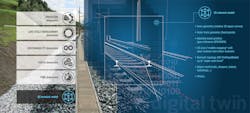Digital twin technology, as a concept, has been around since the early 2000s, but the rapid evolution of data gathering and digitization of information has brought the concept into the realm of reality.
Transit agencies and firms tasked with rail asset management and construction can benefit from the concept of digital twins as a way of understanding the systemwide health of assets and how those assets can support operations most efficiently.
Chris Lund, a partner in Digital Industry Consulting, DXC Technology said, “The digital twin provides information about an asset’s current design, state, condition and its history that inform better decisions about how to manage the current infrastructure and build future infrastructure. Solutions such as Building Information Modelling (BIM), Enterprise Asset Management and Geospatial Information Systems (GIS) help generate information over the entire life of the asset."
Benefits
Bentley Systems, Inc., explains that the most significant value a transit system can achieve by the successful implementation of a digital twin is through using a twin created to plan, design and build the network, to improve its performance during operation and maintenance.
“Just as doctors can analyze human DNA to anticipate health issues and personalize care for better health outcomes, project delivery firms can harness digital engineering information or ‘digital DNA’ to enable collaboration, improve decision making and deliver better project outcomes,” said the company.
Bentley’s OpenRail connected data environment (CDE) makes this possible through a set of cloud-provisioned or on-premise services that support digital context, components and workflows, enabling asset owners and project delivery firms to access consistent, trusted and accurate information across the entire asset lifecycle.
Plasser American Corp. says that while a digital twin can represent one or more components of a rail transit system, the more components that are included, the more value a digital twin will add.
“At the most basic level, maintenance and condition data collected on a wide array of assets allows for analysis of assets without equipment downtime or track possession. When implemented correctly and kept current, it empowers operators to plan and adapt their business processes over time with minimum disruption to day-to-day operations,” said Plasser.
Stukton Rail North America adds that the successful implementation of digital twins combines dozens of siloed and disconnected sources of information to provide a complete picture of the network in real time. Willow Rail, powered by Strukton, is a digital twin platform specific to rail networks and Strukton believes asset management optimization is one area where the technology can be of use.
“In the instance of an irregularity, when using Willow Rail, there’s no waste of time assigning workgroups to maintenance work. A custom mobile application allows direct communication between maintenance teams and asset managers. One can track progress in real time with a unique GIS map, and store all maintenance history, records and details in one place (knowledge sharing),” said Ellen Linnenkamp, vice president, Strukton Rail North America.
Digital twin upkeep
While a digital twin can provide many benefits, maintaining the twin is as important as maintaining the physical assets themselves.
Lund, at DXC, offers a reminder that most transit assets are now equipped with sensors, transducers, communication systems, processors and remote terminals and these smart systems provide passengers and operators with practical route and service information. Lund notes that the use of intelligent equipment does not necessarily result in smarter information.
“To be smart, the data generated from intelligent assets must be integrated with information about the operating environment as part of an enterprise management system that results in better outcomes for the operators, their customers and other stakeholders,” said Lund.
He continued by explaining that asset information itself should be treated as a critical asset due to both assets and asset information being in a state of constant change. Both need to be kept current if they are to be trusted.
“Change management is key when adopting digital twin in an enterprise. Stakeholder support is also critical. To maximize the value of information, organizations need to mature their information management systems. This includes the policies, standards and associated business rules which, when implemented, will enable data and information to be managed in a secure, structured and consistent manner throughout the information life cycle,” said Lund.
Synchronization that represents an asset’s physical reality and its “virtuality” is key to having a reliable twin, but Bentley says merely capturing and representing physical conditions is not enough without also comprehending the “digital DNA” captured in the project’s or asset’s engineering specifications. A concept the company’s iTwinTM Services can help implement through Bentley’s CDE.
“A digital twin can meet this requirement by geospatially converging the digital context (representing the physical) and digital components (representing the virtual), resulting in an immersive environment for both visualization and analytics visibility,” said Bentley.
For Strukton, utilizing automation of data collection and integration has been built into the Willow Rail platform, allowing it to adapt and provide greater insight as more information is gathered. Strukton says this deeper intelligence presents rail operators with a way to learn from existing procedures and run simulations to optimize operations and cost management.
Accuracy of information is another sticking point to building a well-structured digital twin. Plasser American says keeping a digital twin accurate and up-to-date must become one of a rail transit system’s business processes.
“Implementing a true digital twin is a challenging task and requires navigating around technological and operational roadblocks; it requires a holistic approach rooted in experience and expertise. At Plasser, we help our clients with navigating these roadblocks,” the company explained. “The railroad industry, in general, and transit systems, in particular, have been moving in the direction of digitization for several years. Implementing digital twins is a natural evolution in this process.”
Tapping potential
Transit agencies see the potential digital twins can bring to the table, but with other pressing issues, such as maintenance backlogs, progress toward implementation is slow and somewhat piecemeal.
“Think of a puzzle with many pieces; the more pieces put together correctly the more accurate and refined the resulting picture will be,” said Plasser American.
The company notes that it’s PT Connected for condition monitoring of track construction and maintenance machines, as well as its geometry measurement and imaging systems for condition monitoring of track and related infrastructure, are some of the systems commonly used as components of a digital twin. The company services one transit system that is using Plasser-delivered data to analyze track conditions in an office environment, which reduces the need for track time and allows for simultaneous review of several track conditions.
Strukton and Willow have seen early adoption in markets such as Europe and Australia and expect North American rail transit clients to begin in 2019-2020. Strukton believes the slower adoption has been due to North American clients working on other priorities such as backlogs in the state of good repair and limited funding, but expects the technology to become a higher priority as the industry starts to see the benefits.
“A digital twin can make life easier regarding requirements from the FAST Act and Transit State of Good Repair. It drives deeper insights, proactive management and optimization of the rail network. It clearly identifies availability, punctuality, capacity, speed restrictions, interruptions and deviations all within a single interface,” said Linnenkamp of Strukton.
Given that rail is a very traditional and safety-sensitive industry and with the backdrop of owner operators and project delivery firms needing to work within tighter budgets, to shorter deadlines, along with increased legislation, change can often be slow says Bentley.
“[Change] rarely comes easily and the risks associated with changing a tried and tested formula can weigh very heavily on the minds of those responsible,” said the company.
However, Bentley believes the upside is that the highly complex nature of rail networks and systems mean the opportunity to leverage technology to change the way they do business, and deliver improved outcomes for all the stakeholders involved, is very significant.
“We need to accelerate the application of digital technologies and close the productivity gap with others like automotive, aerospace or defense,” said Bentley.
The big question: Will it happen?
“The short answer is yes, it has to! It is no longer enough to simply do things the way they have always been done,” said Bentley. “Our visionary users are actively exploring different strategies for both the creation and curation of digital twins, so that they may continue to deliver the increased levels of service, safety and reliability being demanded of them now and in the future.”
About the Author

Mischa Wanek-Libman
Group Editorial Director
Mischa Wanek-Libman is director of communications with Transdev North America. She has more than 20 years of experience working in the transportation industry covering construction projects, engineering challenges, transit and rail operations and best practices.
Wanek-Libman has held top editorial positions at freight rail and public transportation business-to-business publications including as editor-in-chief and editorial director of Mass Transit from 2018-2024. She has been recognized for editorial excellence through her individual work, as well as for collaborative content.
She is an active member of the American Public Transportation Association's Marketing and Communications Committee and served 14 years as a Board Observer on the National Railroad Construction and Maintenance Association (NRC) Board of Directors.
She is a graduate of Drake University in Des Moines, Iowa, where she earned a Bachelor of Arts degree in Journalism and Mass Communication.
